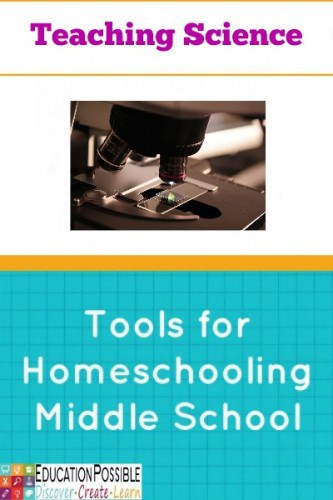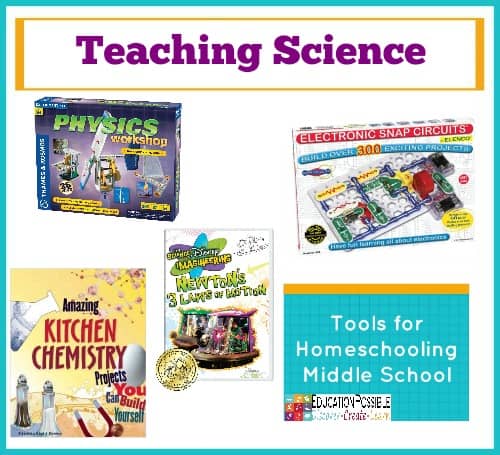Tools for Homeschooling Middle School: Teaching Science
Use these helpful science tools to make middle school science exciting.
Middle school science. Three small words, that when mentioned, immediately evoke a reaction from homeschooling parents, either positive or negative.
Instead of relying on textbooks for our lessons, I use living books, videos, science kits, and experiments to teach my kids how this subject fits into their lives. The hands-on projects are their favorites, so I work hard to make our lessons interactive.
 This post contains affiliate links.
This post contains affiliate links.
Science was not my favorite subject growing up. I hated biology with all of the creepy crawlers and I never really understood chemistry. When we made the decision to homeschool, I knew that I didn’t want to project these feelings on to my girls, so, from the time they were little, any time we encountered “science” (bugs, leaves, rivers, rocks, flowers, birds, etc.) I pasted on a smile and talked about how cool our discovery was.
And you know what? When I took the time and looked at science in the real world, I didn’t have to pretend anymore. Science captured me.
Here are a few of our favorite things we’ve used to make middle school science interesting.
Curriculum
Creative Nature Walks by Shining Dawn Books
This eBook, written by Cindy West, is designed to get you outside exploring. With 100 nature walks included, the large variety of activities are designed to engage all types of learners. Through some of the nature walks, Cindy shows you how to look at nature scientifically. Science activities include making comparisons using Venn diagrams, notebooking, animal tracking, classification, and more.
I love that she included extension ideas for challenging older students.
If you are studying botany, nature, or animals this year for science, this should definitely be a part of your lesson plans.
Electricity and Magnetism by Colleen Kessler
This book not only helps students learn about electricity and magnetism but also includes a number of experiments to make the subjects fun. I used some of the electricity experiments during our science co-op and the kids enjoyed completing them. The instructions were easy to follow and the materials weren’t too expensive.
If you’re looking to add some experiments to your science this year, give this a try.
Books, Videos, & CDs
The Science of Disney Imagineering
We used this series as our “textbook” last year to learn about physical science. The videos, created by Disney Imagineers, show how they use physics to create their famous rides. Every video clearly explains a science theory and shows how it works in real life, specifically how it relates to various Disney attractions.
Janice VanCleave’s books are well-known for making science hands-on. They are full of easy to follow experiments, covering nearly every science topic.
Amazing Kitchen Chemistry Projects You Can Build Yourself by Cynthia Light Brown
This book utilizes materials commonly found in the kitchen to learn about chemistry. Some of the topics covered in the 10 chapters include atoms, mixtures, reactions, acids & bases, solids, liquids, and gases.
This is one of the books we are using this year in our science co-op.

Games & Hands-on Learning Activities
Educational Trivia Card Game – Professor Noggin’s Wonders of Science
A fun and simple card game, full of science trivia.
This kit allows you to build models of simple and complex machines. It includes plans for 37 different experiments. This was a great supplement to our physical science lessons.
Studying geology? Having a collection like this one, with a wide variety of rocks and minerals already identified for you, comes in very handy. My kids really enjoyed being able to touch and test the samples when we learned about geology.
If you are learning about electricity, consider getting a snap circuit kit to enhance your lessons. There are over 300 projects included, guaranteed to provide hours of discovery. By snapping various parts together, kids learn all about electronics.
Online Resources
Entomology- The Science of Insects by Blog She Wrote
Homeschool Reviews for Nature Study, Science, and Technology by the Curriculum Choice Authors
The Ins & Outs of Science Fairs by Eva Varga
Project-Based Learning: Microbes – Fungus by Angelicscalliwags
Science Experiments: Why You Should Do Them and How to Get Them Done from Bright Ideas Press
From the Education Possible Archives:
- 10 Volcano Activities for Middle School
- Groovy Science Activity – Make Your Own Lava Lamp
- Learning with Other Families: How to Start a Science Co-op
- Meet African Animals at Disney’s Animal Kingdom
- Science Activities to Learn About Levers
- Simple Science: Catapults and Trajectory
For more fun science ideas, check out our Hands-on Science Pinterest Board! That’s where most of our experiment ideas come from.
Follow Education Possible’s board Hands-on Science on Pinterest.



Thanks for including The Homeschool Scientist! What a great list of resources! The one thing I might add is a good microscope or Discovery Scope. Those have opened up a whole new world for our kids.
You’re welcome Marci! I love your site and I was happy to share it with our readers. I completely agree that a microscope is a great tool to have. Unfortunately I haven’t purchased one yet, so I didn’t have one to recommend. Thank you for sharing the idea though! I’m definitely adding it to my list.
What a fabulous collection of resources! Thank you for including my science fair post! 🙂
Thank you Eva! I LOVED your science fair post! So many families are afraid of science fairs, so I was happy to share your wisdom with our readers.
I think I would like to play with some of these things myself! Great list!
Thank you Ashley! I agree – that’s why I make science as interactive and fun as possible. I want to enjoy myself too!!